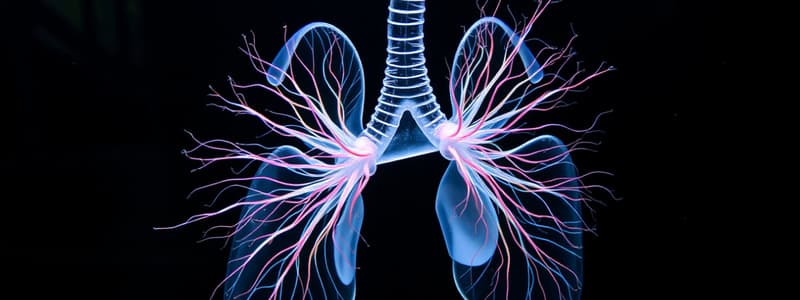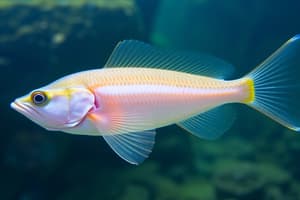Podcast
Questions and Answers
What is the primary function of gills in aquatic arthropods and molluscs?
What is the primary function of gills in aquatic arthropods and molluscs?
- To assist in buoyancy control
- To support locomotion
- To aid in digestion
- To facilitate gas exchange (correct)
Which component of the human respiratory system serves as the sound box?
Which component of the human respiratory system serves as the sound box?
- Bronchi
- Trachea
- Larynx (correct)
- Pharynx
What is the role of the epiglottis during swallowing?
What is the role of the epiglottis during swallowing?
- To create a seal in the trachea
- To produce vocal sounds
- To cover the larynx (correct)
- To assist in food breakdown
What structure directly follows the nasal passage in the human respiratory system?
What structure directly follows the nasal passage in the human respiratory system?
How do amphibians like frogs contribute to their respiration?
How do amphibians like frogs contribute to their respiration?
Which of the following parts of the respiratory system is supported by incomplete cartilaginous rings?
Which of the following parts of the respiratory system is supported by incomplete cartilaginous rings?
What is true about the lungs in mammals?
What is true about the lungs in mammals?
Which statement is true regarding the pleura surrounding the lungs?
Which statement is true regarding the pleura surrounding the lungs?
What is the primary function of the conducting part of the respiratory system?
What is the primary function of the conducting part of the respiratory system?
Which statement accurately describes the role of the alveoli in the respiratory system?
Which statement accurately describes the role of the alveoli in the respiratory system?
What anatomical feature separates the conducting part from the exchange part of the respiratory system?
What anatomical feature separates the conducting part from the exchange part of the respiratory system?
In which part of the respiratory system does actual diffusion of gases occur?
In which part of the respiratory system does actual diffusion of gases occur?
What is the anatomical status of the thoracic chamber regarding the lung?
What is the anatomical status of the thoracic chamber regarding the lung?
What is the relationship between the outer and inner pleural membranes?
What is the relationship between the outer and inner pleural membranes?
Which of the following components does NOT belong to the conducting part of the respiratory system?
Which of the following components does NOT belong to the conducting part of the respiratory system?
What role does pleural fluid play in the respiratory system?
What role does pleural fluid play in the respiratory system?
What happens to intra-pulmonary pressure during inspiration?
What happens to intra-pulmonary pressure during inspiration?
Which of the following describes Tidal Volume (TV)?
Which of the following describes Tidal Volume (TV)?
What role do the external inter-costal muscles play in breathing?
What role do the external inter-costal muscles play in breathing?
How can the strength of breathing be increased during inspiration and expiration?
How can the strength of breathing be increased during inspiration and expiration?
What is the average respiratory rate for a healthy human?
What is the average respiratory rate for a healthy human?
What is the average range for Inspiratory Reserve Volume (IRV)?
What is the average range for Inspiratory Reserve Volume (IRV)?
What occurs to the diaphragm and sternum during expiration?
What occurs to the diaphragm and sternum during expiration?
What does a spirometer measure?
What does a spirometer measure?
What is the reason diffusion of gases occurs only in the alveolar region?
What is the reason diffusion of gases occurs only in the alveolar region?
In which condition would the pO2 in alveolar air be lesser compared to atmospheric air?
In which condition would the pO2 in alveolar air be lesser compared to atmospheric air?
What defines the oxygen dissociation curve?
What defines the oxygen dissociation curve?
How does an increase in pCO2 affect oxygen transport?
How does an increase in pCO2 affect oxygen transport?
What is the approximate tidal volume for a healthy human during normal breathing?
What is the approximate tidal volume for a healthy human during normal breathing?
What happens to the respiratory process when a person ascends a hill?
What happens to the respiratory process when a person ascends a hill?
What accurately describes the term 'partial pressure' as it relates to gases?
What accurately describes the term 'partial pressure' as it relates to gases?
How does the partial pressure of oxygen change from the alveoli to the blood?
How does the partial pressure of oxygen change from the alveoli to the blood?
What is the direction of the concentration gradient for carbon dioxide during gas exchange?
What is the direction of the concentration gradient for carbon dioxide during gas exchange?
Which gas has the highest partial pressure in atmospheric air, based on the provided information?
Which gas has the highest partial pressure in atmospheric air, based on the provided information?
What information can be inferred about the solubility of gases from the diffusion rates?
What information can be inferred about the solubility of gases from the diffusion rates?
In which area is carbon dioxide's partial pressure highest when comparing the different sites of diffusion?
In which area is carbon dioxide's partial pressure highest when comparing the different sites of diffusion?
Which condition could decrease the rate of diffusion of oxygen from the alveoli to the blood?
Which condition could decrease the rate of diffusion of oxygen from the alveoli to the blood?
How does the concentration gradient affect gas diffusion in the body?
How does the concentration gradient affect gas diffusion in the body?
Flashcards are hidden until you start studying
Study Notes
Gas Exchange Structures
- Aquatic arthropods and molluscs use gills, while terrestrial animals utilize lungs for gas exchange.
- Fish respire using gills; reptiles, birds, and mammals utilize lungs.
- Amphibians, such as frogs, can respire through their moist skin.
- Mammals possess a well-developed respiratory system.
Human Respiratory System Structure
- External nostrils lead to the nasal chamber and pharynx, shared passage for food and air.
- Pharynx connects to the larynx, which is involved in sound production and is known as the sound box.
- Larynx covers the glottis with the epiglottis during swallowing to prevent food entry.
- Trachea extends to the mid-thoracic cavity, dividing into right and left primary bronchi.
- Bronchi further divide into secondary and tertiary bronchi, eventually forming bronchioles and terminal bronchioles.
- Terminal bronchioles lead to alveoli, the gas exchange structures, making up the lungs.
Lung Anatomy and Function
- Lungs are covered by a double-layered pleura with pleural fluid to reduce friction.
- Conducting part (nostrils to terminal bronchioles) transports, humidifies, and filters air.
- Respiratory part (alveoli and ducts) facilitates the diffusion of O2 and CO2 between blood and air.
- Lungs are housed in an air-tight thoracic chamber.
Mechanism of Breathing
- Contraction of external intercostal muscles increases thoracic and pulmonary volume, leading to inspiration.
- Relaxation of diaphragm and intercostal muscles decreases thoracic volume, leading to expiration.
- Average human respiration rate is 12-16 breaths per minute.
- Breathing volume can be assessed using a spirometer.
Respiratory Volumes and Capacities
- Tidal Volume (TV): Approx. 500 mL air per breath, totaling 6000-8000 mL per minute for a healthy adult.
- Inspiratory Reserve Volume (IRV): Additional 2500-3000 mL air can be forcibly inhaled.
- Expiratory Reserve Volume (ERV): Additional 1000-1100 mL air can be forcibly exhaled.
Diffusion Characteristics
- Rate of gas diffusion influenced by gas solubility and membrane thickness.
- Partial pressure: Individual gas pressure in a mixture, denoted as pO2 for oxygen and pCO2 for carbon dioxide.
- Concentration gradients exist for O2 and CO2 between alveoli, blood, and tissues facilitating gas exchange.
Partial Pressure Data
- Atmospheric pressure for O2 is 159 mm Hg; for CO2, it is 0.3 mm Hg.
- Alveolar O2 pressure is 104 mm Hg; CO2 pressure is 40 mm Hg.
- Blood oxygenated pressure is 95 mm Hg; deoxygenated CO2 pressure is 45 mm Hg.
- Tissues have pO2 of 40 mm Hg and pCO2 of 45 mm Hg.
Respiratory Physiology
- Understanding vital capacity, the volume of air that can be exhaled after a maximum inhalation, is vital for assessing lung function.
- Residual volume: Air remaining in lungs after normal breathing, crucial for continuous gas exchange.
- Diffusion occurs mainly in the alveolar region due to the thin walls and large surface area.
Additional Insights
- The relationship between partial pressures influences the direction of gas diffusion.
- Exercise, high altitude, and environmental factors impact respiratory function and efficiency.
- Oxygen dissociation curve’s sigmoidal pattern reflects hemoglobin's affinity for oxygen under varying conditions.
Studying That Suits You
Use AI to generate personalized quizzes and flashcards to suit your learning preferences.




